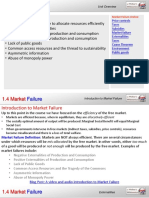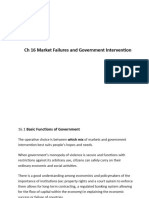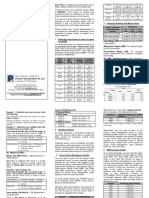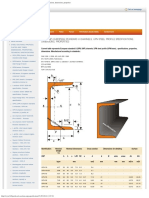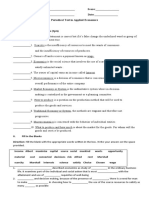Valueing Benefits and Costs
Valueing Benefits and Costs
Uploaded by
Dandza PradityaCopyright:
Available Formats
Valueing Benefits and Costs
Valueing Benefits and Costs
Uploaded by
Dandza PradityaOriginal Description:
Original Title
Copyright
Available Formats
Share this document
Did you find this document useful?
Is this content inappropriate?
Copyright:
Available Formats
Valueing Benefits and Costs
Valueing Benefits and Costs
Uploaded by
Dandza PradityaCopyright:
Available Formats
Valuing Benefits & Costs (Part 2) +
Discounting Benefits & Costs (Part 1)
Lecture 4 SPM9716: Chapters 4 & 5 + Chapter 6 (part 1)
Dr. ir. Zenlin Roosenboom-Kwee
z.roosenboom-kwee@tudelft.nl
Challenge the future 1
Course Outline & Schedule
Challenge the future 2
Valuing Benefits in Distorted
Markets
• Distorted markets = inefficient markets projects’ benefits
are still measured as ∆ social surplus + net revenues
• Five different types of market failures
1. Monopoly & natural monopoly (refer to Lecture 3)
2. Information asymmetry
3. Externalities
4. Public goods
5. Addictive goods
Challenge the future 3
Information Asymmetry (IA)
• The two effects can be corrected if (non)governmental
sources provide the needed information
• Source of information depends on the type of good:
• Search good (e.g. notebooks) IA is unlikely to be a serious
problem
• Experience goods (e.g. movie tickets, restaurants) reduces IA
• Post-experience goods (e.g. a prescription drug) IA persists
for long periods of time
Challenge the future 4
Externalities
• An externality: an effect that production or consumption of a
good has on third parties
• Two potential effects of an externality:
• Market underestimates the social cost of a good (negative)
• Market overestimates the social benefit of the good (positive)
• What can governments do?
• Negative externalities: require producers to pay a tax on each
unit they sell
• Positive externalities: subsidize production of the good or
produce some of the good
Challenge the future 5
Public Goods
• Two key attributes:
• Nonexcludable: it is impossible (impractical) for one person to
maintain control over the use of a good free-rider problem
• Nonrivalrous: more than one person can obtain benefits from a
given level of supply at the same time free-rider problem
• Some goods are either nonrivalrous or nonexcludable (but
not both!)
• Example of nonrivalrous (but excludable): toll road
• Example of nonexcludable (but rivalrous): fishing in international
waters
Challenge the future 6
Addictive Goods
Economic models
of addictive goods
(e.g. tobacco):
today’s
consumption
depends on the
amount of previous
consumption
Challenge the future 7
Valuing Inputs: Opportunity Costs
• Opportunity costs: value of the goods and services that would have
been produced had the resources (used to implement the policy)
been used in the best alternative way
• Opportunity costs are not sunk costs
• To measure opportunity costs, direct budgetary outlay is normally
used
• Three situations where direct budgetary outlay is compared with
conceptually appropriate measures:
1. Efficient markets with negligible price effects budgetary outlay is
accurate (caution: perfectly elastic vs. perfectly inelastic supply curves)
2. Efficient markets with noticeable price effects budgetary outlay may
slightly overstate opportunity costs (see Fig. 4-13)
3. Inefficient market may substantially overstate/understate
opportunity costs
Challenge the future 8
Figure 4-13 Opportunity Costs with Price Effects
Benefits Costs
Original buyers A+B
Sellers A+B+C
Project B+C+G+E+F
expenditures
Net social cost B+G+E+F
Challenge the future 9
General rule for market distortions
• When supply is taxed, direct expenditure outlays
overestimate opportunity cost
• When supply is subsidized, expenditures underestimate
opportunity cost
• When supply exhibits positive externalities, expenditures
overestimate opportunity cost
• When supply exhibits negative externalities, expenditures
underestimate opportunity cost
• General rule: Opportunity cost = direct expenditures on the
factor minus (plus) gains (losses) in social surplus occurring
in the factor market
Challenge the future 10
Primary & Secondary Markets
• Primary (secondary) markets: markets that are directly (indirectly)
affected by a policy
• Indirect effects in secondary markets are also referred to as
secondary, second-round, spillover, side, pecuniary effects
• As government policies affects prices of goods in primary markets
the effects in secondary markets, changes of demand for:
• Complements: goods that tend to be purchased and used with
another good (e.g. hamburger buns)
• Substitutes: goods that can be used in place of another good (e.g.
hotdogs are substitutes for hamburgers)
• The effect in primary markets may or may not affect the price in
secondary markets
Challenge the future 11
Efficient secondary market effects
without price changes
• The impacts in efficient secondary markets should be ignored
if:
• the prices in the secondary markets do not change; and
• the change in social surplus in the primary market is measured
• Example: fishing days (primary) and fishing equipment
(secondary, complement)
Challenge the future 12
Figure 5-1(a) Primary Market: Market for Figure 5-1(b) Secondary Market: Market for
Fishing Days Fishing Equipment (No Price Effect)
SS = CS = PF0abPF1 Gain in CS = efdc
Should we include this gain in the
social benefits of the primary market?
Challenge the future 13
Efficient secondary market effects
with price change
• When the price in the secondary market changes, situation is
more complex
• Example: fishing days (primary) and golfing days (secondary,
substitute)
• Efficient secondary market effects (regardless of price
changes) are ignored as long as benefits in the primary
market are measured using empirically measured (observed)
demand curves
Challenge the future 14
Figure 5-2(a) Primary Market: Market for Fishing Days Figure 5-2(b) Secondary Market: Market for
Golfing Days (Price Effects)
Increase in CS = PF0abPF1
Increase in CS (practice) = PF0acPF1 Increase in CS = PG0efPG1
Understatement of CS = abc Reduction in PS = PG0gfPG1
Net loss in SS = efg
Challenge the future 15
Case Example: Japanese vs.
American cars
• Japanese cars are substitutes for American cars
• To improve U.S. sales, there is a need to limit the imports of
Japanese cars
• Voluntary Restraint Agreement (VRA) in 1981
• What are the impacts or consequences of the limit on
imports?
Challenge the future 16
Distorted Secondary Markets
• Distorted markets: markets in which price does not equal
social marginal costs
• When there are distortions in secondary markets, effects
must be valued separately (difficult to measure in practice)
• Fortunately, these effects are usually small and can be
ignored
• Examples: negative externalities and taxes
Challenge the future 17
Exercise 5.1 Recall Exercise 4.2 (Lecture 3 slide#7) in which an
increase in the toll on a highway from $.40 to $.50 would
reduce use of the highway by 10,000 cars per week
a. Because of the reduced use of the highway, demand in the secondary market for
subway rides increases. Assuming that the price of subway rides is set equal to
the marginal cost of operating the subway and marginal costs are constant (i.e.
the supply schedule is horizontal), and no externalities result from the reduced
use of the highway and the increased use of the subway, are there additional
costs or benefits due to the increased demand for subway rides? Why or why
not?
b. Because of the reduced use of the highway, demand in the secondary market for
gasoline falls by 30,000 gallons per year. There is a stiff tax on gasoline, one that
existed prior to the new toll. Assuming that the marginal cost of producing
gasoline is $1 per gallon, that these marginal costs are constant (i.e., the supply
schedule is horizontal), that no externalities result from the consumption of
gasoline, and that the gasoline tax adds 30 percent to the supply price, are there
any additional costs or benefits due to this shift? If so, how large are they?
Challenge the future 18
Indirect effects of infrastructure
projects
• The analysis is similar to the analysis of effects in secondary
markets
• The indirect effects can be ignored if:
• The product markets in which the indirect effects occur are
undistorted
• The surplus changes that occur in primary markets are fully
measured
Challenge the future 19
The Basics of Discounting
(Projects with lives of one year)
• Three possible methods
• Future Value (FV) analysis
FV = X (1 + i) ; X = amount invested and i = interest rate
• Present Value (PV) analysis
PV = Y/(1 + i) ; Y = amount received
• Net Present Value (NPV) analysis
NPV = PV(benefits) – PV(costs)
• NPV > 0 select project
• NPV < 0 reject project; maintain status quo
Challenge the future 20
City Land Purchase Example (Figures 6-1 and 6-2)
i = 5%
PV(B) = 11,000 / (1+0.05)
PV(B) = 10,476,190
PV(C) =
NPV = $476,190
Challenge the future 21
Compounding and Discounting
over multiple years
• Future value: FV= X (1+i)n ; (1+i)n = compound interest factor
• Present value: ; 1/(1+i)n = PV factor or discount factor
• Net present value:
When costs occur at the
beginning (t=0):
; NBi = Bi - Ci = −
(1 + )
Challenge the future 22
Figure 6-4 Time Line of the Benefits and Costs of the Library
Information System
i = 7%
Challenge the future 23
Annuity and Perpetuity
• Many CBAs contain annuities or perpetuities
• Annuity: an equal, fixed amount received (or paid) each year
for a number of years
(annuity factor)
(annuity with a constant
growth rate)
• Perpetuity: an indefinite annuity
(perpetuity with a constant
growth rate)
Challenge the future 24
Timing of Benefits and Costs
• When do benefits and costs exactly occur?
• At the beginning of the year
• At the end of the year
• If they arise throughout the year:
• Compute NPV as if the benefits/costs occurred in the middle of
the year
• Or take the average (at the beginning of the year and at the end
of the year) to compute NPV
Challenge the future 25
Exercise 6.1: A highway department is considering building a temporary
bridge to cut travel time during the three years it will take to build a
permanent bridge. The temporary bridge can be put up in a few weeks at a
cost of $750,000. At the end of three years, it would be removed and the steel
would be sold for scrap. The real net cost of this would be $81,000. Based on
estimated time savings and wage rates, fuel savings, and reductions in risks of
accidents, department analysts predict that the benefits in real dollars would be
$275,000 during the first year, $295,000 during the second year, and $315,000
during the third year. Departmental regulations require use of a real discount
rate of 4 percent.
a. Calculate the present value of net benefits assuming that the benefits are
realized at the end of each of the three years.
b. Calculate the present value of net benefits assuming that the benefits are
realized at the beginning of each of the three years.
c. Calculate the present value of net benefits assuming that the benefits are
realized in the middle of each of the three years.
d. Calculate the present value of net benefits assuming that half of each
year’s benefits are realized at the beginning of the year and the other half
at the end of the year.
e. Does the temporary bridge pass the net benefits test?
Challenge the future 26
Intertemporal Comparison of Projects
• When the time spans are different, projects are not directly
comparable
• Example: A government-owned electric utility company is
considering two new alternative sources of power
• Alternative 1: hydroelectric dam (HED), NPV 75-year project =
$30 million
• Alternative 2: cogeneration plant (CGP), NPV 15-year project =
$24 million
• Is the hydroelectric project preferable simply because it has the
large NPV?
• Two relevant methods:
1. Roll-over method
2. Equivalent annual net benefits (EANB) method
Challenge the future 27
Roll-Over Method
• If tprojectA = n * tprojectB
• Example: Project A lasts 30 years and project B lasts 15 years
• Compare NPV project A to the NPV of 2 back-to-back project B
• Project B = + where: x = NPV of one15-year
( )
project B
• Previous HED and CGP example: Suppose that in 15 years time
another new cogeneration plant is built; in 30 years another one
is built; and again in 45 and 60 years (assume i = 8%)
$ !" $ !"
5 = $24 + ++ +
( . $) ( . $)%&
$ !" $ !"
+ + = $34.94 + ,, -.
( . $)' ( . $)(&
Higher than NPV of 75-year HED
($30 million) select this option
Challenge the future 28
Equivalent Annual Net Benefits (EANB) Method
• EANB: the amount received each year for the life of the project
has the same NPV as the project itself (amortization)
• EANB = NPV/ ain
• ain is the present value of an annuity of $1 for the life of the project
1 − (1 + )0
/ =
• n = years
• i = interest rate used to compute the NPV
• Choose the project with the highest EANB
• HED and CGP example:
• EANB(HED) = $30/12.461 = $2.407 million
• EANB(CGP) = $24/8.559 = $2.804 million
If one could continuously replace each
project at the end of its life with a similar
project, choose CGP
Challenge the future 29
You might also like
- UseCases TetrisDocument22 pagesUseCases TetrisDandza PradityaNo ratings yet
- Social Cost Benefit AnalysisDocument60 pagesSocial Cost Benefit AnalysisAmmrita SharmaNo ratings yet
- 2010 'A' Level H1 Essay Q3 (Updated 25 June) (LT5)Document4 pages2010 'A' Level H1 Essay Q3 (Updated 25 June) (LT5)JohnNo ratings yet
- Guidelines Regarding Registration of Independent Floors' - Policy 9Document26 pagesGuidelines Regarding Registration of Independent Floors' - Policy 9Manish Prasad Sinha100% (1)
- Chapter 3Document50 pagesChapter 3wudineh debebeNo ratings yet
- Welfare Economics and Efficiency, Property Right,Document43 pagesWelfare Economics and Efficiency, Property Right,Takele HonjaNo ratings yet
- PSE Chapter 2Document23 pagesPSE Chapter 2jemalseid241No ratings yet
- 5-Market Failure and ExternilitiyDocument25 pages5-Market Failure and ExternilitiyGaurav KumarNo ratings yet
- Chapter 11 Economic Efficiency - Market FailureDocument23 pagesChapter 11 Economic Efficiency - Market FailureNur NatiraahNo ratings yet
- Lecture Note-Session 41Document6 pagesLecture Note-Session 41Vij88888No ratings yet
- Externalities (54383)Document102 pagesExternalities (54383)Fiza ChopraNo ratings yet
- Cost Benefit Analysis L4Document3 pagesCost Benefit Analysis L4EllaNo ratings yet
- Ch-3 Market Failure by Pratham SinghDocument9 pagesCh-3 Market Failure by Pratham SinghRohith PrakashNo ratings yet
- Chapter 6 Part C:Social costs and benefits的副本Document36 pagesChapter 6 Part C:Social costs and benefits的副本wangsiqi201666No ratings yet
- Economic Analysis For Agricultural and Environmental SciencesDocument30 pagesEconomic Analysis For Agricultural and Environmental SciencesSenthil SNo ratings yet
- Cost Benefit Analysis L3Document3 pagesCost Benefit Analysis L3EllaNo ratings yet
- Public Good and ExternalityDocument47 pagesPublic Good and ExternalityDaksh AnujNo ratings yet
- Market Failure1Document37 pagesMarket Failure1shubhamNo ratings yet
- Public Good and ExternalityDocument43 pagesPublic Good and ExternalityPriyankaNo ratings yet
- CA Chapter 15-03-05Document14 pagesCA Chapter 15-03-05D DNo ratings yet
- Micro & MacroDocument11 pagesMicro & MacroFarzam MehdiNo ratings yet
- Assignment From Lecture IV: 1. Multiple Choice QuestionsDocument6 pagesAssignment From Lecture IV: 1. Multiple Choice QuestionsJ. Nawreen100% (1)
- 1.4 Market FailureDocument42 pages1.4 Market FailureTita RachmawatiNo ratings yet
- 1.4 Market FailureDocument42 pages1.4 Market FailureRuban PaulNo ratings yet
- IB Economics Teacher Resource 3ed Paper 1 AnswersDocument19 pagesIB Economics Teacher Resource 3ed Paper 1 AnswersIzyan Lirani100% (2)
- Surplus DefinitionDocument62 pagesSurplus Definitionkalyan_mallaNo ratings yet
- BIE Exam 9 September 2020 Text and SolutionsDocument5 pagesBIE Exam 9 September 2020 Text and SolutionsomerogolddNo ratings yet
- Econ Notes - Market Failure IBDPDocument43 pagesEcon Notes - Market Failure IBDPvansheekasarin07No ratings yet
- Mgeb02 4Document14 pagesMgeb02 4nigaroNo ratings yet
- Economics StuffDocument5 pagesEconomics StuffVigneshNo ratings yet
- Chapter 3 - The Analysis of Competitive MarketsDocument14 pagesChapter 3 - The Analysis of Competitive MarketsJiedan HuangNo ratings yet
- 2.8X Market Failure - Externalities and Common Pool or Common Access Resources Includes HL Only Calculation 2Document102 pages2.8X Market Failure - Externalities and Common Pool or Common Access Resources Includes HL Only Calculation 2TQSMalek RefaieNo ratings yet
- Ebookfiles 1541Document50 pagesEbookfiles 1541rdnidsquidNo ratings yet
- Chapter 2 - Market Failure-FinDocument49 pagesChapter 2 - Market Failure-Findwi_Lvmausna0% (1)
- BC30603 Presentation5-Valuing Benefits and Cost in Secondary MarketsDocument34 pagesBC30603 Presentation5-Valuing Benefits and Cost in Secondary MarketsboynazreyNo ratings yet
- Ec 213- Market Failure Lecture SlidesDocument34 pagesEc 213- Market Failure Lecture Slidesdicksonagness82No ratings yet
- Negative Consumption ExternalityDocument15 pagesNegative Consumption ExternalityMandeep KaurNo ratings yet
- CH 4 - Role of GovernmentDocument43 pagesCH 4 - Role of Governmentmahimann BhardwajNo ratings yet
- Ch-3 Property RightDocument41 pagesCh-3 Property Rightferewe tesfayeNo ratings yet
- Cost Benefit Analysis L2Document3 pagesCost Benefit Analysis L2EllaNo ratings yet
- Micro Fundamentals (Part 2) - 2016Document30 pagesMicro Fundamentals (Part 2) - 2016Bahaa TakieddineNo ratings yet
- Eco Assignment 01 SolutionDocument16 pagesEco Assignment 01 SolutionyoungdholpurNo ratings yet
- Lecture 7Document13 pagesLecture 7ashrrakat31No ratings yet
- ECON REVDocument15 pagesECON REVRakshana krishnanNo ratings yet
- Get Microeconomics 5th Edition Besanko Test Bank Free All ChaptersDocument51 pagesGet Microeconomics 5th Edition Besanko Test Bank Free All Chaptersyerixifessa100% (8)
- Exercise 5 - Solution PDFDocument14 pagesExercise 5 - Solution PDFyumenashi2No ratings yet
- Market FailureDocument42 pagesMarket FailureYacine100% (1)
- Ngo I TácDocument43 pagesNgo I TácNguyễn Bá Tài AnhNo ratings yet
- hcp08 ExternalitiesDocument59 pageshcp08 Externalitieserincmc.55No ratings yet
- Market Success and Market FailureDocument32 pagesMarket Success and Market Failuremahajanmayur50% (2)
- L2 Slope and Elasticity, Consumer and Producer Surplus, ApplicationDocument25 pagesL2 Slope and Elasticity, Consumer and Producer Surplus, ApplicationpeisinchaoNo ratings yet
- Scribbles 1Document47 pagesScribbles 1Richie ChanNo ratings yet
- Economics: ANSWER KEY - March 2019Document13 pagesEconomics: ANSWER KEY - March 2019Jim Carlo Abegonia AmansecNo ratings yet
- Ch01 IntroductionDocument23 pagesCh01 Introductioncoco lee yee kerNo ratings yet
- Week Eight - Market FailuresDocument33 pagesWeek Eight - Market FailuresVidarshaNo ratings yet
- 110B Only Micro Ch.16Document19 pages110B Only Micro Ch.16izelvilliNo ratings yet
- Padam, S UNIDO ApproachDocument80 pagesPadam, S UNIDO Approachpadam_gnimNo ratings yet
- MonopolyDocument45 pagesMonopolyvohir14625No ratings yet
- SCBADocument31 pagesSCBAraggarwal101No ratings yet
- 2 Efisiensi Pasar Dan PemerintahDocument27 pages2 Efisiensi Pasar Dan PemerintahFadhila Bondan SukmawatiNo ratings yet
- Imperfect CompetitionDocument40 pagesImperfect CompetitionSezgin TokalaçNo ratings yet
- 012 IntroductionDocument10 pages012 IntroductionDandza PradityaNo ratings yet
- Slide Case EDM03 - Group 3Document59 pagesSlide Case EDM03 - Group 3Dandza PradityaNo ratings yet
- 05 UML Part2Document61 pages05 UML Part2Dandza PradityaNo ratings yet
- Van Wee 2012 How Suitable Is CBA For Transport Projects EthicsDocument7 pagesVan Wee 2012 How Suitable Is CBA For Transport Projects EthicsDandza PradityaNo ratings yet
- Discounting BC and CEADocument24 pagesDiscounting BC and CEADandza PradityaNo ratings yet
- Network Stakeholder EngagementDocument38 pagesNetwork Stakeholder EngagementDandza PradityaNo ratings yet
- Overview of CBADocument39 pagesOverview of CBADandza PradityaNo ratings yet
- Making Your Own CBADocument1 pageMaking Your Own CBADandza PradityaNo ratings yet
- 02 DDDDocument107 pages02 DDDDandza PradityaNo ratings yet
- 01 Oop For RealDocument51 pages01 Oop For RealDandza PradityaNo ratings yet
- Microeconomic Foundations of CBADocument19 pagesMicroeconomic Foundations of CBADandza PradityaNo ratings yet
- 12 SecurityTestingDocument62 pages12 SecurityTestingDandza PradityaNo ratings yet
- IoT IntroDocument65 pagesIoT IntroDandza PradityaNo ratings yet
- IoT ArchitectureDocument60 pagesIoT ArchitectureDandza PradityaNo ratings yet
- ICT Section Colloquium - PradityaDocument15 pagesICT Section Colloquium - PradityaDandza PradityaNo ratings yet
- IFIP I3E - 2016 - Praditya Et AlDocument17 pagesIFIP I3E - 2016 - Praditya Et AlDandza PradityaNo ratings yet
- Drone EmpritDocument77 pagesDrone EmpritDandza PradityaNo ratings yet
- Canapi 04 Activity 2Document2 pagesCanapi 04 Activity 2sora fpsNo ratings yet
- There Are Several Types of BondsDocument6 pagesThere Are Several Types of BondsAbhishekNo ratings yet
- Prelim TopicsDocument9 pagesPrelim TopicsCherryvic Alaska - KotlerNo ratings yet
- CFAS - Lec. 7 PAS 19 Employee BenefitsDocument22 pagesCFAS - Lec. 7 PAS 19 Employee Benefitslatte aeriNo ratings yet
- Cash Plus Account InfosheetDocument4 pagesCash Plus Account InfosheetEdmund KohNo ratings yet
- 2023 Spring Final Sample QuestionDocument21 pages2023 Spring Final Sample Questionqwer qwerNo ratings yet
- 12 Theories of FinanceDocument15 pages12 Theories of Financehira malikNo ratings yet
- Past Exam Papers - Accounting Ieb NSC Grade 12 Past Exam Papers 2022 p1 MemoDocument11 pagesPast Exam Papers - Accounting Ieb NSC Grade 12 Past Exam Papers 2022 p1 MemoCamilleNo ratings yet
- 2023 Lhaviyani Turtle Festival-2Document10 pages2023 Lhaviyani Turtle Festival-2Jithu S PillaiNo ratings yet
- WEBEX Numeros GlobalesDocument5 pagesWEBEX Numeros Globalessaint Gobain1No ratings yet
- UPN (UNP) European Standard U Channels, UPN Steel Profile SpecificationsDocument2 pagesUPN (UNP) European Standard U Channels, UPN Steel Profile SpecificationsParthiban BalasubramaniamNo ratings yet
- BANKING INDUSTRY: A More Sustainable Growth Underpins Stable OutlookDocument30 pagesBANKING INDUSTRY: A More Sustainable Growth Underpins Stable OutlookMai HoangNo ratings yet
- Script For EconomicsDocument5 pagesScript For EconomicsDen mark RamirezNo ratings yet
- Assignment 2 (FA18-BBA-095)Document3 pagesAssignment 2 (FA18-BBA-095)Hamza RafaeyNo ratings yet
- RD 2Document22 pagesRD 2som dutt sharmaNo ratings yet
- Conceptual Framework and Accounting Standards (CFAS)Document5 pagesConceptual Framework and Accounting Standards (CFAS)Dummy GoogleNo ratings yet
- Report MatrixDocument3 pagesReport Matrixhayaton408No ratings yet
- Imsu Past Questions Non Sci 13 19Document43 pagesImsu Past Questions Non Sci 13 19Stephen OgechiNo ratings yet
- APPLIED Periodical TEST 2nd SemDocument3 pagesAPPLIED Periodical TEST 2nd SemOne ClickNo ratings yet
- Silvercrest Announces Positive Feasibility Study Results and Technical Report Filing For The Las Chispas ProjectDocument10 pagesSilvercrest Announces Positive Feasibility Study Results and Technical Report Filing For The Las Chispas ProjectMahdi Tukang BatuNo ratings yet
- ChargesDocument57 pagesChargesdeepika sawantNo ratings yet
- Fundamental Analyzis of WiproDocument15 pagesFundamental Analyzis of WiproAthira K. ANo ratings yet
- HI5020 Corporate Accounting: Session 12b Translating The Financial Statements of Foreign OperationsDocument17 pagesHI5020 Corporate Accounting: Session 12b Translating The Financial Statements of Foreign OperationsFeku RamNo ratings yet
- Statement DF0PY2YC4-1 Issued 02 - 01 - 2023Document2 pagesStatement DF0PY2YC4-1 Issued 02 - 01 - 2023Mohamed GhalebNo ratings yet
- HANC65390900-3x40hc Đóng Ngày 13 OctDocument2 pagesHANC65390900-3x40hc Đóng Ngày 13 OctHanh NguyenNo ratings yet
- Nifty 50 Option Strategy For The March 2024 SeriesDocument4 pagesNifty 50 Option Strategy For The March 2024 Seriesyashbhadage7No ratings yet
- Proof of PaymentDocument1 pageProof of Paymentclariceganesan28No ratings yet
- Gajalapalli VillageDocument1 pageGajalapalli VillageSasiNo ratings yet
- RU V Balikpapan - Fire Water Distribution - RRDocument2 pagesRU V Balikpapan - Fire Water Distribution - RRsugeng wahyudiNo ratings yet























